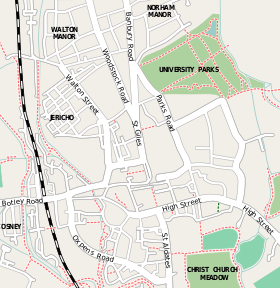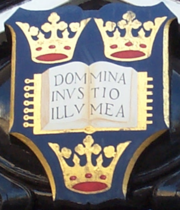Lincoln College, Oxford

|
|
||||||||||||
| College name | Lincoln College | |||||||||||
| Named after | Richard Fleming, Bishop of Lincoln | |||||||||||
| Established | 1427 | |||||||||||
| Sister college | Downing College, Cambridge | |||||||||||
| Rector | Prof. Paul Langford | |||||||||||
| JCR president | Jøno Lain | |||||||||||
| Undergraduates | 285 | |||||||||||
| MCR president | Christine Simpson | |||||||||||
| Graduates | 220 | |||||||||||
|
|
||||||||||||
 Location of Lincoln College within central Oxford |
||||||||||||
| Homepage | ||||||||||||
Lincoln College (in full: The College of the Blessed Mary and All Saints, Lincoln) is one of the constituent colleges of the University of Oxford in the United Kingdom. It is situated in the centre of Oxford, lying on Turl Street next to Exeter and backing onto Brasenose. As of 2006, Lincoln had an estimated financial endowment of £69m.[1]
Contents |
History
The College was founded on October 13th 1427 by Richard Fleming, then Bishop of Lincoln, (cadaver tomb in Lincoln Cathedral) to combat the Lollard teachings of John Wyclif. He intended it to be "a little college of true students of theology who would defend the mysteries of Scripture against those ignorant laymen who profaned with swinish snouts its most holy pearls".
Due to insufficient endowment, however, the College seems only to have survived thanks to the munificence of a second Bishop of Lincoln, Thomas Rotherham, who effectively re-founded it in the 1470s.
In the 18th century Lincoln became the cradle of Methodism when John Wesley, at that time a fellow there, held religious meetings with his brother Charles.
In the next century, Lincoln was the first college in Oxford (or Cambridge) to admit a Jewish Fellow, the Australian-born philosopher Samuel Alexander (appointed 1882).
Years after the success of his Cold War spy novels, novelist and Lincoln graduate John le Carré, himself a one-time spy, revealed that fictional spymaster George Smiley was modelled on former Lincoln rector Vivian H. H. Green. At least one other recent Lincoln Rector, Sir Maurice Shock, enjoyed a prior career in British intelligence, although there is little evidence to substantiate the college's reputation as a recruiting ground for spies.
The College was the first in Oxford or Cambridge to provide a Middle Common Room exclusively for the use of graduate students. Lincoln has admitted women since the 1970s.
In 2007, the College took the rare step of unveiling a commissioned portrait of two members of staff who were not fellows or benefactors of the College, in commemoration of their work. Chef Jim Murden and Butler Kevin Egleston have worked in the College's Kitchen and Buttery for 31 and 26 years respectively, as of 2008. Noted artist Daphne Todd was commissioned for the painting, who has had such notable sitters as HRH the Grand Duke of Luxembourg and Spike Milligan.[2]
The College is known as being the setting for many literary works, such as Thomas Hardy's Jude the Obscure. It has also been the setting for 3 episodes of Inspector Morse. Recently, Lewis has used Turl Street in front of the College for filming.
The College at Present
Academically, Lincoln has consistently been one of the top ten colleges in the Norrington Table for some years. Its library holds some 60,000 books and is a popular place for graduates and undergraduates alike to work, especially given that it is open until 2am most nights compared to the earlier closing time of the Bodleian and faculty libraries.
As is common with Oxford colleges, the College has a longstanding rivalry with neighbour Brasenose College. The two colleges share a tradition known as Ascension Day. The story goes that, centuries ago, as a mob chased students at the University through the town, the Lincoln porter allowed in the Lincoln students but refused entry to the Brasenose member, leaving him to the mercy of the mob. An alternative is that a Lincoln man bested a Brasenose man in a duel. Either episode resulted in the Brasenose student's death, and ever since, on Ascension Day, Lincoln College has invited in members of Brasenose College every year through the one door connecting the two colleges, for ivy beer as penance; not, as is often mischievously suggested, poison ivy but a harmless fragrant sort used to flavour the beer to pleasant effect. It is, however, suggested that the original tradition of flavouring the beer with ivy was to discourage them from consuming too much of Lincoln's beer.
Architecture
According to Nikolaus Pevsner, Lincoln College preserves "more of the character of a 15th century college than any other in Oxford". This is mainly because both the facade to Turl Street and the front quad are still of only two storeys (although the parapets and battlements are of the 19th century). The College also owns most of the buildings across Turl Street from the college proper, in whole or in part, which chiefly contain student accommodation.
There are three quads - front quad (15th century), chapel quad (1608–1631) and grove quad (19th century, more properly the Grove) - as well as a number of irregular spaces.
The college chapel was built in late perpendicular style between 1629 and 1631. The college's library is located in the converted 18th century church of All Saints, handed over to the college in 1971. All Saints churchtower is a notable feature of Oxford's skyline, one of the city's "dreaming spires". The Rector's lodgings in Turl Street are neo-Georgian and were built in 1929–1930; they are reached from within college through a gate in Chapel Quad.
Unlike many other colleges, all of the architecture of the college proper is mediaeval stone and there is no modern accommodation annexe. To quote the Lincoln College Freshers' Handbook, "Unlike most colleges, we have no grotty sixties annexe to spoil all the pretty bits". The college bar, Deep Hall (or Deepers), is immediately below the great hall and used to be the college beer cellar. It is one of the oldest parts of the college, and the pillars inside it are perhaps the oldest feature of the college. It is through Deep Hall that the JCR, MCR and college wine cellars are accessed, the latter of which extends completely beneath the Grove.
Student accommodation
The college is one of relatively few in Oxford to guarantee all undergraduates three years of college-owned accommodation. Similarly, virtually all graduate students are provided housing for the duration of their studies.
The college's housing stock is extensive and centrally-located. About 80 students live on the three quads described above, with over 100 more living in rooms above the shops on the other side of Turl Street. Further accommodation is provided at Bear Lane (across High Street) and at Museum Road (by Keble College). A number of outlying houses make up the remainder of the housing stock.
Junior Common Room

Due to Lincoln's small numbers and tightly-knit community, its Junior Common Room (JCR) plays a greater role in student life than do the JCRs of most other colleges. JCR elections, held in Trinity and Michaelmas Terms, attract one of the highest turnouts of any Oxford college. The JCR is run by an Executive group of officers, headed by the President. The JCR President for 2008–9 is Jøno Lain. His recent predecessors are Peter Morcos (2007–8), Nicolas Long (2006–7), Oliver Munn (2005–6), Alasdair Henderson (2004–5), Mairi Brewis (2003–4) and Phil Bownes (2002–3). JCR meetings are held three times a term.
Notable former students
- See also: Category:Alumni of Lincoln College, Oxford
- Peter Ainsworth — MP for East Surrey
- Bill Cash — MP for Stone
- Steph Cook — modern pentathlete and Olympic gold medallist
- David Craig, Baron Craig of Radley — House of Lords crossbencher and former Chief of the Defence Staff
- Theodore "Dr Seuss" Geisel (1904–1991) — writer and cartoonist
- J.A. Hobson (1858–1940) — Liberal thinker and political theorist
- Girish Karnad — Indian playwright, film actor and director
- John le Carré — author
- David Lewis (1909–1981) — Canadian MP and leader of the New Democratic Party
- Rachel Maddow — American radio personality and political analyst
- Maulana Mohammad Ali (1878–1931) — Indian Muslim leader, journalist and poet
- John Morley — Liberal statesman and writer
- Emily Mortimer — actress
- Chukwuemeka Ojukwu — Biafran secessionist
- Osbert Lancaster — cartoonist, critic and author
- Sir Peter Parker (1924–2002) — Chairman of the British Railways Board, 1976–1983
- Tom Paulin — poet
- Jamie Shea — NATO spokesman
- William Sholto Douglas (1893–1969) — RAF pilot and WWII military commander
- Sir John Stanley — MP for Tonbridge and Malling
- Edward Thomas (1878–1917) — poet
- Colin Winter (1928-1981) — bishop and anti-apartheid activist
Academics/teachers
- See also: Category:Fellows of Lincoln College, Oxford
- Edward Abraham (Sir Edward) (Fellow 1948–1999)
- Peter Atkins (Fellow 1965–2007, Acting Rector 2007)
- Howard Florey(Lord Florey) (Fellow 1934–1962)
- Susan Greenfield (Fellow 1985–present)
- Norman Heatley (Fellow 1948-1978, Supernumerary Fellow 1978–2004)
- Keith Murray (Fellow 1937–1993, Rector 1944–1953)
- Mark Pattison (Fellow 1839–1884, Rector 1861–1884)
- John Potter (Fellow 1694–1747)
- John Radcliffe (Fellow 1670–1675)
- Nevil Sidgwick (Fellow 1901–1958)
- John Wesley — theologian and founder of methodism
- Vivian H. H. Green (Fellow 1951–2005, Rector 1983–1987)
References
- ↑ Oxford College Endowment Incomes, 1973-2006 (updated July 2007)
- ↑ "Lincoln honours loyal partnership". Lincoln College News (Baseline Oxford): 9. August 2008.
|
|||||||||
